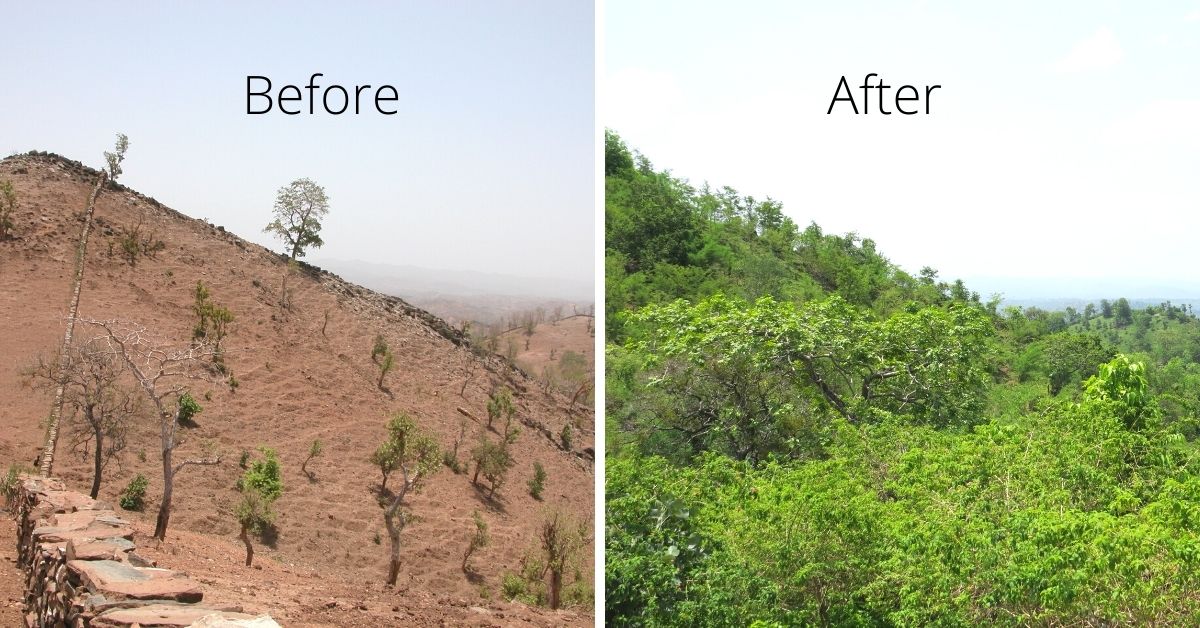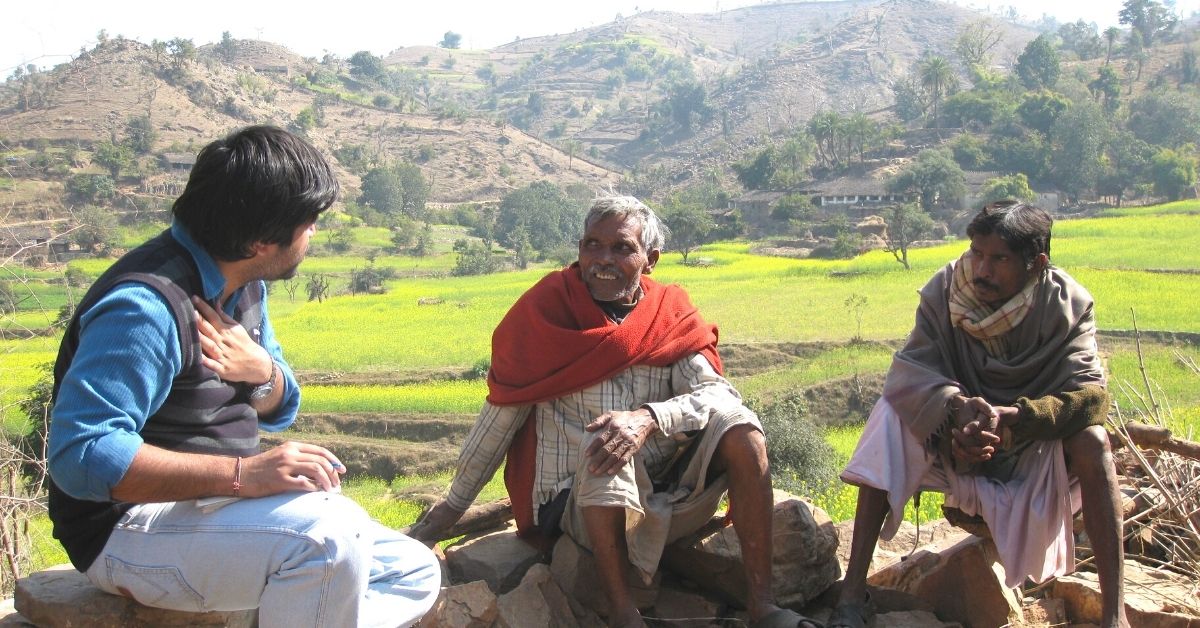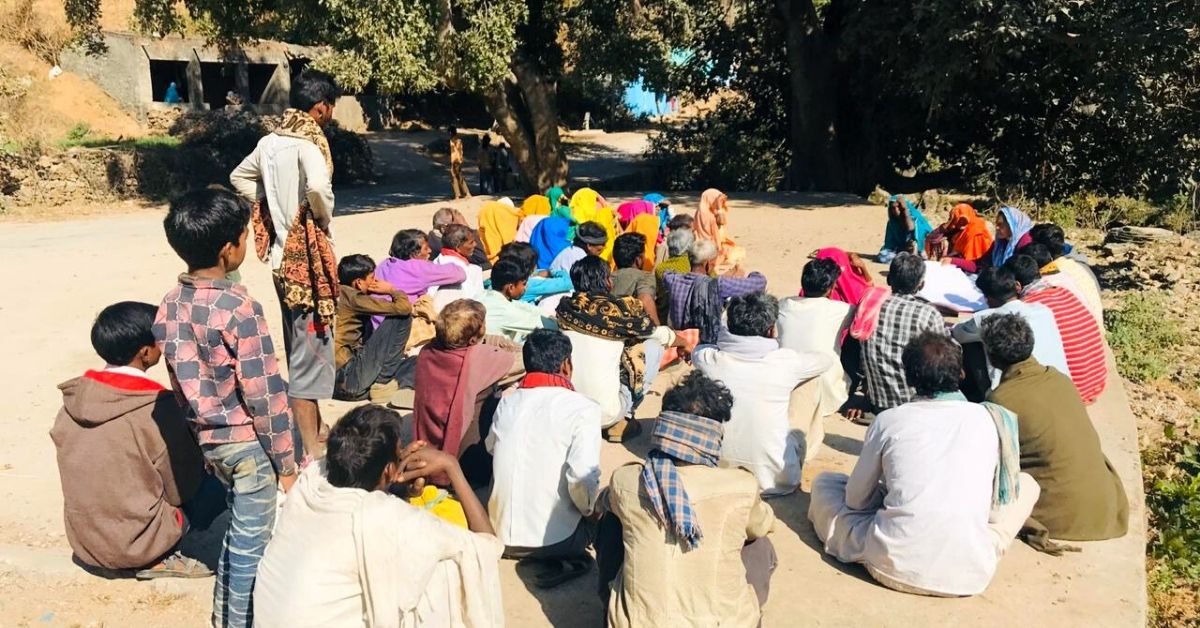Fighting Climate Change, Rajasthan Villagers Turn Barren Land To Dense Forest
Residents of Karech in Rajasthan sought help from the Foundation of Ecological Security to restore wastelands through community efforts and save their village from desertification and loss of livelihood

Karech, a village around 75 km from Udaipur, is probably the last village in western Rajasthan. The residents belong to tribal communities and their subsistence depends on agriculture, livestock rearing and the sale of firewood from forests. However, in recent years, they have observed increasing desertification threaten their village.
It was in early 2000 that residents like Hansa Ram, former village head, noticed degrading common forest lands. The phenomena indicated that the village was moving towards desertification. Factors responsible for this included soil erosion, loss of vegetation, depleting surface water and groundwater resources, and other anthropological aspects such as deforestation. The deteriorating conditions had forced the residents to seek opportunities outside, leading to migration.
In fact, according to a report published by The Energy and Resources Institute (TERI), India is losing 30% of its land to desertification and Rajasthan is among the six states facing acute degradation.
However, in 2021, the villagers in Karech have a different story to tell. They no longer face the threat of losing their forests to desertification, as they have managed to restore 339 hectares of common land owned by the village community for collective use.
By the community, for the community

Hansa Ram says, “The village is located in the foothills of the Aravalli hill ranges, which prevent the harsh weather of the desert from entering the neighbouring Mewar region as well as eastern Rajasthan. Due to the loss of green cover, our village did not have a barrier, and we lay exposed.”
He adds that overgrazing, exploitation of forest resources, and deforestation led to the rapid disappearance of land, and that the area could have been encroached by the desert. “We wanted to address the problem but found it difficult to bring 600 villagers together due to the social hierarchy,” he says.
In 2002, the villagers took help from the Foundation of Ecological Security (FES), an organisation that works for the regeneration of degraded natural resources, including village commons such as forests, pastures, wastelands and water resources.
Punaram Gadasiya, then sarpanch (head of the village) of Chitrawas (of which Karech village was a part), met FES members who were coincidently surveying common lands to explore opportunities of facilitating restoration of degraded lands through community action in the region.
“The discussions led the sarpanch to share these problems, and the village decided to seek FES’s assistance for claiming and restoring their forest commons,” Hansa Ram says.
FES helped the villagers form the Van Suraksha aur Prabandhan Samiti, a forest protection and management committee, under the Joint Forest Management provisions. The committee, led by Hansa Ram, started working to protect, conserve and manage community resources.

Karech residents in a meeting.
Moti Ram, another resident of Karech, says, “It was challenging to bring together people of higher and lower castes to sit under one roof and discuss the issues around the protection of common lands. Slowly, however, the mindset changed as discussions progressed and people realised their goals were common.”
Moti Ram says villagers collectively chalked out plans and implemented rules for conservation and resource management and followed to date. “Only one person from each family is allowed to collect firewood and forest resources to ensure optimal use of forest resources. Moreover, a dedicated area is allotted for grazing, while the remaining area is allowed to regenerate. Each year, 9 hectares of the common lands are kept open for livestock grazing,” he explains.
Additionally, the villagers refrain their cattle from grazing on young saplings and grasses to ensure adequate growth. To make sure that villagers abide by the rules, each family from the village participates in the vigil using the lathi system, where households take turns to patrol the forest areas.
“The system ensures there are no violations, and fines are slapped if any villager is spotted breaking the rules. For example, violators pay a fine of Rs 50 if their cattle are seen grazing in the restricted area. There are heavy fines for collecting excess firewood,” he adds.
The residents implemented the practices in patches of 50 hectares at a time. Today, the village boasts of a dense green cover across over 300 hectares that serve as a source of livelihood and sustainability for the communities, as well as a barrier protecting the settlement from desertification.
Residents also diverted water from a nearby stream for cultivating crops. Over the years, the increased green cover has helped improve groundwater levels, thus allowing the soil to retain moisture and yielding kharif and rabi crops.
“Earlier, the farmers could hardly take a single crop, but can now take 2-3 harvests on the increased farmland area. Wheat, corn, toor, mustard, moong and groundnut are some of the crops cultivated,” Moti Ram says.
Alongside protection, soil and moisture conservation work, as well as tree planting activities are undertaken to revegetate the forest commons. The villagers planted 1 lakh native trees, conduced grass seedings and worked towards natural regeneration of the forest.
However, Abi T. Vanak, senior fellow at the centre for biodiversity and conservation at Bengaluru based ATREE, advises caution before taking forestation drives. “Degraded lands need to be ecologically restored keeping in mind both the baseline vegetation, as well as the cultural and social context. Trying to grow a dense forest in a dry landscape is as damaging as cutting trees in a rainforest,” he says.
Exemplar of resilience

Asha Chovaliya from FES, who has closely worked with the community, says that a Women Advisory Committee was also formed for better resource management. “The community planted bamboo, gooseberry, mahua, custard apple and other fruit trees that could help people earn money. Women understand the value of economics and conservation better and hence were allotted the rights. They now take pride in having control and protecting their resources,” she adds.
The village is now moving ahead to access Community Forest Rights under Forest Rights Act (2006). “The residents are working to gain more control over their common lands and resources, which will help them work better towards improving the environment and managing forest resources for improved ecological, social and economic outcomes,” she adds.
Having transformed over the years, today, Karech has become an exemplar of resilience and sustainability. The villagers have fought a battle with climate change and inspired neighbouring villages across four blocks. Their efforts demonstrate how local communities can manage shared resources and play a crucial role in environmental conservation while also strengthening local livelihoods.
Edited by Divya Sethu
If you found our stories insightful, informative, or even just enjoyable, we invite you to consider making a voluntary payment to support the work we do at The Better India. Your contribution helps us continue producing quality content that educates, inspires, and drives positive change.
Choose one of the payment options below for your contribution-
By paying for the stories you value, you directly contribute to sustaining our efforts focused on making a difference in the world. Together, let's ensure that impactful stories continue to be told and shared, enriching lives and communities alike.
Thank you for your support. Here are some frequently asked questions you might find helpful to know why you are contributing?


This story made me
-
97
-
121
-
89
-
167














